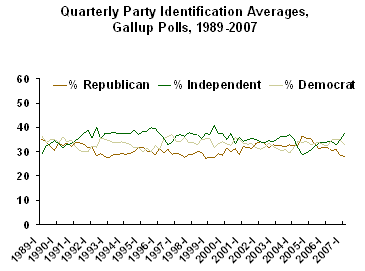
Posted on 04/12/2007 8:50:07 AM PDT by areafiftyone
GALLUP NEWS SERVICE
PRINCETON, NJ -- Recent Gallup polling continues to show a favorable political environment for the Democratic Party. Democrats maintained a significant advantage in partisan identification throughout the first quarter of 2007. Additionally, by a sizable margin, Americans say they would rather see the Democrats than the Republicans win the 2008 presidential election. A ray of hope for Republicans exists in that their leading presidential contenders are currently viewed more positively by Americans than the leading Democratic presidential contenders. Also, the Republican candidates are highly competitive with the Democratic candidates in head-to-head match-ups.
Party Support
During the first quarter of 2007, an average of 33% of Americans identified as Democrats, 28% as Republicans, and 38% as independents. Several things are notable about these numbers.

The Democratic edge becomes obvious and more impressive when looking at not just party identification, but also party "leaning." In each poll it conducts, Gallup asks those who identify as independents whether they lean more to the Democratic or Republican Party. Generally speaking, partisan leaners' attitudes and reported behaviors are more like those of party identifiers than those with no party attachment or leaning.
These days, a greater proportion of independents express a leaning toward the Democratic Party than the Republican Party. When party leanings are taken into account, the 5-percentage-point Democratic advantage on national partisanship from the first quarter grows to 12 points, 52% to 40%.
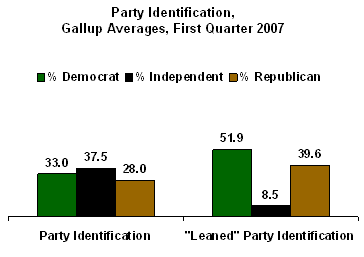
The disproportionate leaning toward the Democratic Party among independents has been evident since early 2005. During the first term of Bush's presidency, independents' leanings broke about evenly between the two parties.
Democrats had a slightly larger 14-point advantage on leaned-party identification in the final quarter of 2006 than its 12-point edge in the most recent quarter. But those two gaps in favor of the Democrats are the largest Gallup has measured for either party in any quarterly average since it began regularly tracking leaned-party identification in 1991. (Gallup did ask leaned-party identification prior to 1991, though not on a consistent basis. Historical data indicates that Democratic advantages in leaned-party identification even greater than the recent 14-point edge were not uncommon in the 1950s, 1960s, and 1970s).
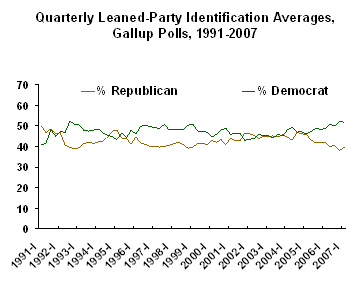
Looking Ahead to 2008
Democrats capitalized on their advantage in partisanship by winning both houses of Congress in last fall's midterm elections. Now they have their sights set on capturing the White House and earning partisan control of both the federal and executive branches of government for the first time since 1993-1994, during Bill Clinton's first two years as president.
In its April 2-5, 2007 poll, Gallup asked Americans if they would rather see the Republicans or Democrats win the 2008 presidential election if the election were held today. The public chose the Democrats by a solid 50% to 35% margin.
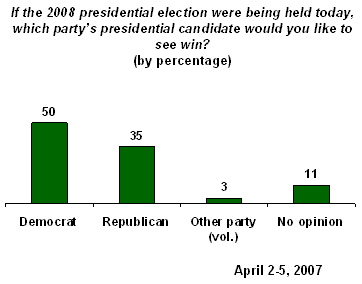
Democrats show stronger party loyalty on this question than do Republicans -- 96% of Democrats (and 91% of Democrats and Democratic leaners) want their party's candidate to win, compared with 84% of Republicans (and 80% of Republicans and Republican leaners).
That apparent Democratic dominance does not emerge, however, when Americans are asked to choose among actual candidates. For example, when Gallup tested preferences between the two leading Republican contenders (Rudy Giuliani and John McCain) and the two leading Democratic contenders (Hillary Clinton and Barack Obama), in only one of the four match-ups did a candidate have a statistically significant lead among registered voters, and that was a Republican (Giuliani) over a Democrat (Obama).
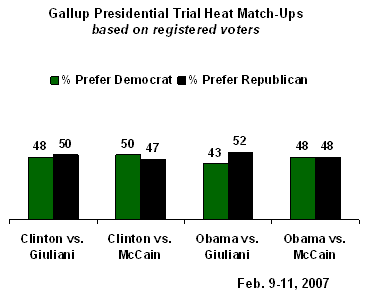
More recent surveys conducted by other polling organizations show the same general pattern -- a tight race if not a Republican lead on these general election trial heats. In fact, a Democratic candidate only leads when matched against a relatively unknown Republican candidate, such as Mitt Romney or Fred Thompson.
The relatively poor performance of the specific Democratic candidates in comparison with the generic ballot may be because, as of now, the leading Republican presidential candidates are viewed more favorably by Americans than are the leading Democrats.
|
Favorable Ratings of Presidential Candidates, April 2-5, 2007 Gallup Poll |
||||
|
Party |
Favorable |
Unfavorable |
No opinion |
|
|
|
% |
% |
% |
|
|
Rudy Giuliani |
Rep |
61 |
27 |
12 |
|
John McCain |
Rep |
57 |
26 |
17 |
|
John Edwards |
Dem |
53 |
30 |
18 |
|
Al Gore |
Dem |
50 |
44 |
6 |
|
Barack Obama |
Dem |
49 |
24 |
26 |
|
Hillary Rodham Clinton |
Dem |
47 |
49 |
4 |
|
Mitt Romney |
Rep |
25 |
21 |
54 |
|
Fred Thompson |
Rep |
24 |
11 |
65 |
Currently, Giuliani has the highest favorable rating of the major presidential candidates, at 61%, followed by McCain, at 57%. All of the major Democratic candidates' ratings hover around 50%, including Clinton and Al Gore who also have the highest unfavorable ratings.
In particular, Clinton's favorable rating has declined in recent weeks. It had been 54% in early March and 58% in early February. After she released her autobiography in 2003, her favorable rating went above 50% and had not gone below that mark until last month.
Romney and Thompson have low favorable ratings but are still largely unknown figures, as at least half of Americans are unable to give them a rating. Thompson is viewed much more positively than negatively by people who are familiar with him, while views of Romney are about evenly split.
Based on these poll results, it is unclear which party would win if the election were held today. Clearly, the political environment favors the Democrats, given their advantage in party affiliation and their generic preference for a Democratic president. But the partisan political conditions may be less of a factor in presidential elections than in midterm elections. Because Republican candidates are able to offset, if not completely overcome, the existing Democratic advantage in the head-to-head match-ups against the Democratic candidates supports this notion. However, it should be noted that these trial heat match-ups are generally not good predictors of what will happen on Election Day this far out, particularly when the candidates are not well-known.
The trial heats will become more predictive as the election draws nearer, but by that time the political environment may look very different than it does today. First, as is typical in a presidential election year, the percentage of Americans identifying as independents will likely decline and fall back below 30% in 2008, making an increase in Republican identification (or leaning) likely. The question is if any gains in Republican identification will exceed any possible gains in Democratic identification or leaning and reduce the current Democratic advantage.
As for the candidates, as Giuliani, McCain, and Obama campaign for the presidency, they will come to be viewed more as partisan figures, and their unfavorable ratings will likely increase as supporters of the opposing party will find it difficult to give them a positive review. Also, the candidates may look better or worse to Americans than they do now when they are evaluated against the backdrop of the key election issues of 2008, whether those are the Iraq war, terrorism, the economy, or another issue that emerges, such as healthcare or moral values.
Survey Methods
These results are based on telephone interviews with a randomly selected national sample of 1,008 adults, aged 18 and older, conducted April 2-5, 2007. For results based on this sample, one can say with 95% confidence that the maximum error attributable to sampling and other random effects is ±3 percentage points. In addition to sampling error, question wording and practical difficulties in conducting surveys can introduce error or bias into the findings of public opinion polls.
And will hemorrage base, which is needed to win a primary. Independents don’t get to vote.
Disclaimer: Opinions posted on Free Republic are those of the individual posters and do not necessarily represent the opinion of Free Republic or its management. All materials posted herein are protected by copyright law and the exemption for fair use of copyrighted works.